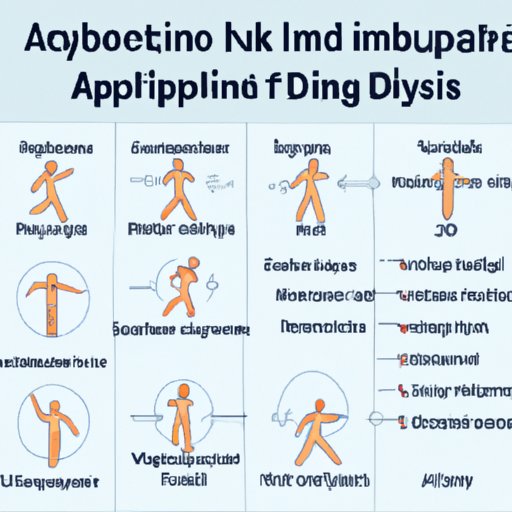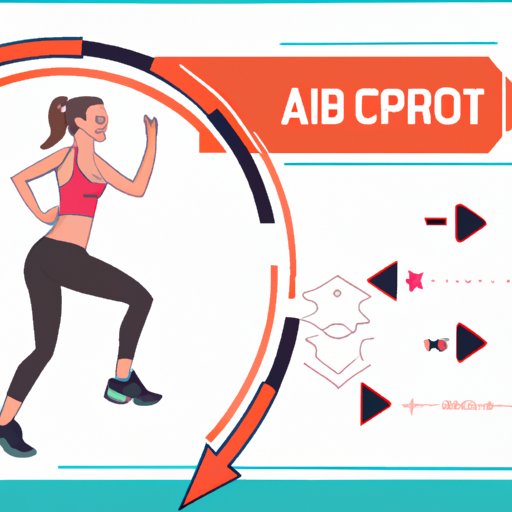Introduction
Aerobic exercise is an integral part of a healthy lifestyle. It can help improve cardiovascular health, increase energy levels, promote weight loss, and reduce stress. But what exactly is aerobic exercise? How does it differ from other forms of exercise? This article will explore the definition and benefits of aerobic exercise, as well as provide a guide for incorporating it into your life.
Definition of Aerobic Exercise
The American Heart Association defines aerobic exercise as “any activity that uses large muscle groups, can be maintained continuously, and is rhythmic in nature.” In other words, it is any type of physical activity that increases your heart rate and breathing rate, such as walking, running, swimming, cycling, or using an elliptical machine. The key is to keep your body moving for an extended period of time, typically 20 minutes or more.
Types of Aerobic Exercise
There are various types of aerobic exercise, each with its own benefits. Cardio exercises such as walking, running, swimming, and cycling are great for improving cardiovascular health and increasing endurance. Strength training exercises such as weightlifting and calisthenics can also be considered aerobic since they use large muscle groups and can be done for an extended period of time. High-intensity interval training (HIIT) is another form of aerobic exercise that alternates between intense bursts of activity and low-intensity intervals. Low-impact exercises such as yoga and Pilates are excellent for those who have joint issues or are just starting out on their fitness journey.

Benefits of Regular Aerobic Exercise
Regular aerobic exercise has numerous health benefits. According to a study published in the American Journal of Clinical Nutrition, aerobic exercise can help reduce the risk of cardiovascular disease, Type 2 diabetes, and certain types of cancer. It can also help improve overall cardiovascular health by strengthening the heart and lungs and increasing lung capacity. Additionally, regular aerobic exercise can help boost energy levels, aid in weight loss, and reduce stress.
Common Mistakes to Avoid When Doing Aerobic Exercise
When doing aerobic exercise, it is important to avoid making common mistakes that can lead to injury or fatigue. One mistake to avoid is not staying hydrated. Drinking plenty of water before, during, and after your workout is essential for preventing dehydration. Another mistake to avoid is not warming up properly. Taking time to warm up your muscles before exercising can help prevent injury and fatigue. Additionally, it is important to avoid overdoing it. Start slowly and gradually increase the intensity of your workout. Finally, make sure to maintain proper form while exercising to ensure you get the most benefit out of it.

Guide to Different Types of Aerobic Exercises
Walking is a great form of aerobic exercise that can be done anywhere. Running is another popular form of aerobic exercise that can be done outdoors or on a treadmill. Swimming is an excellent full-body workout that can be done in a pool or lake. Cycling is a great way to get your heart rate up and can be done indoors on a stationary bike or outdoors on a road bike. Rowing machines are an effective way to work the major muscles in the body. Elliptical machines are a low-impact option for those who have joint issues. Jumping rope is a fun way to get your heart rate up and can be done anywhere. Finally, yoga is an excellent form of low-impact aerobic exercise that can help improve flexibility and reduce stress.

How to Incorporate Aerobic Exercise into Your Life
Incorporating aerobic exercise into your life doesn’t have to be intimidating. Start by setting goals for yourself. Make a plan for how you will reach those goals and track your progress. Find motivation by joining a gym or signing up for classes. Incorporate variety into your workouts by trying different types of exercise. Finally, listen to your body and take breaks when necessary.
Conclusion
Aerobic exercise is an important part of any fitness routine. It can help improve cardiovascular health, increase energy levels, promote weight loss, and reduce stress. There are various types of aerobic exercise, including cardio exercises, strength training, high-intensity interval training (HIIT), and low-impact exercises. To incorporate aerobic exercise into your life, set goals, make a plan, track your progress, find motivation, incorporate variety, and listen to your body. With the right approach, you can reap the many benefits of aerobic exercise.
(Note: Is this article not meeting your expectations? Do you have knowledge or insights to share? Unlock new opportunities and expand your reach by joining our authors team. Click Registration to join us and share your expertise with our readers.)
